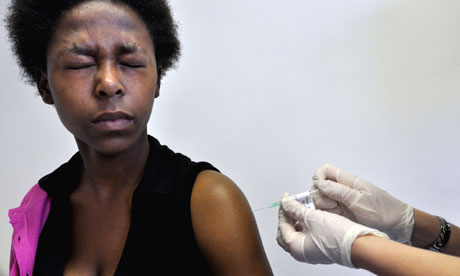
No matter what your age, here's how to make sure you're in good health.
1. Audiogram
Why you need it: To find out if you are one of the more than 28 million Americans with measurable hearing loss and, if so, to take steps to keep it from worsening.
When and how often: Schedule an audiogram if you have trouble making out what people are saying, hear ringing in your ears, feel a plugged sensation, or have a family history of hearing loss. Otosclerosis, a genetic disorder that prompts abnormal growth of the bone of the middle ear, is more prevalent in women and often surfaces when a woman is pregnant or between 15 and 30.
What to expect: You wear headphones while a licensed audiologist or ear, nose, and throat doctor has you listen to sounds. "We check for your ability to discriminate between tones of different frequencies," says David Fabry, a former president of the American Academy of Audiology.
What the results mean: If your audiogram is normal, you'll come back every two to five years for a follow-up test. If your audiogram shows you have high-pitch hearing loss, you may have more difficulty hearing certain voices and might need a hearing aid.
_________________________________________________
More From Real Simple:
A Thorough Examination of Medical Clinics
Everyday Strategies to Boost Your Immunity
What Do Health Experts Really Eat?
__________________________________________________
2. Bone-Mineral Density Test
Why you need it: To find out whether you're at risk for osteoporosis. This crippling weakness of the bones afflicts nearly 10 million older Americans, 80 percent of whom are women, according to the National Osteoporosis Foundation.
When and how often: Have your first DXA (dual-energy X-ray) test at age 65 and another every five years thereafter. Women can lose up to 30 percent of their bone mass in the five to seven years following
menopause. Get tested at menopause if you weigh less than 127 pounds, have ever smoked, have a history of nontraumatic fractures as an adult, or have a family history of osteoporosis.
What to expect: The DXA test, the most accurate bone-density test, is safe and noninvasive: You lie fully clothed on a table while the X-ray machine scans your spine, hips, and wrists. If your bone density is low, your doctor may recommend the NTX test, a urine test that measures the rate at which you're losing bone mass; she may also want you to be X-rayed annually.
What the results mean: If your DXA shows you have osteopenia, a preosteoporotic state of low bone density, your doctor will recommend you consume at least 1,000 milligrams of calcium and 400 to 800 IUs of vitamin D daily without fail. (All women should get this amount, in fact.) She'll also suggest regular exercise. If you have osteoporosis, your doctor may give you a drug like
Actonel or
Fosamax.
3. Clinical Breast Exam and Mammogram
Why you need it: Both types of screening can detect breast cancer when it is confined to the breast. Ninety-seven percent of women diagnosed at this stage survive without a recurrence for at least five years, according to the
American Cancer Society.
When and how often: Starting when you're age 20, your doctor should manually examine your breasts at your regular checkup. By age 40, you should have a mammogram (an X-ray of the breasts) once a year. "Schedule your mammogram right after your period," says Dr. Holly Thacker. "That's when the breasts are least tender."
What to expect: Mammograms are done by standard X-ray. "If you've had previous mammograms and you're now using a new facility, be sure the radiologist compares your old films with the current ones," says Dr. Suzanne Trupin, a clinical professor of obstetrics and gynecology at the University of Illinois College of Medicine at Urbana-Champaign.
What the results mean: If the mammogram picks up an abnormality, such as a small deposit of calcium or a mass, your doctor may ask you to undergo a breast ultrasound or in some cases a breast MRI. These tests can determine whether a lump is a solid mass and if a biopsy is necessary.
4. Colonoscopy
Why you need it: To detect colorectal cancer before symptoms occur. In Its early stage, this disease is more than 90 percent curable, says Bernard Levin, M.D., vice president for cancer prevention and professor of medicine at the University of Texas M.D. Anderson Cancer Center, in Houston.
When and how often: Doctors suggest you have your first colonoscopy at age 50. If a parent or sibling was diagnosed with colorectal cancer or polyps before 50, you are at higher risk and should get your first test 10 years before they were diagnosed and repeat it at least every five years. If no problems are found and you have no family history, testing can be limited to once every 10 years.
What to expect: For a colonoscopy, the gold-standard diagnostic test, your doctor uses a colonoscope, an instrument with a tiny video camera, to examine your large intestine for polyps and other growths.
What the results mean: If polyps are found, they will be removed and biopsied, says Dr. David E. Beck, chairman of the department of colon and rectal surgery at the Ochsner Clinic Foundation, in New Orleans. Depending on the results, you may need surgical treatment or additional testing within three to five years.
5. Dental Screening
Why you need it: To rule out oral cancer, one of the six most common cancers among American adults, according to the Academy of General Dentistry, and to combat gum disease and treat any tooth decay.
When and how often: Twice-a-year teeth cleanings and checkups should begin six months after your baby teeth appear and continue for life. If you're pregnant or taking contraceptives, you may be more prone to gum inflammation. Smokers and women who have more than a drink or two a day are at a greater risk for gum disease and oral cancers.
What to expect: A dentist will take a close look at all your teeth, your tongue, the soft and hard tissues of your mouth and neck, and the area around your jaw to determine if there are any unusual changes in tissue.
What the results mean: If you have gum disease, your dentist may recommend that you return for cleanings more than twice a year. You may also have plaque and tartar scraped from above and below the gum line and rough spots on tooth roots smoothed. If you have abnormal tissue growths, your dentist may take a biopsy.



















